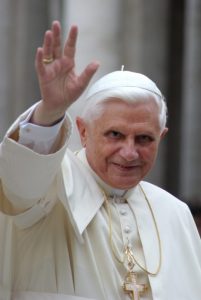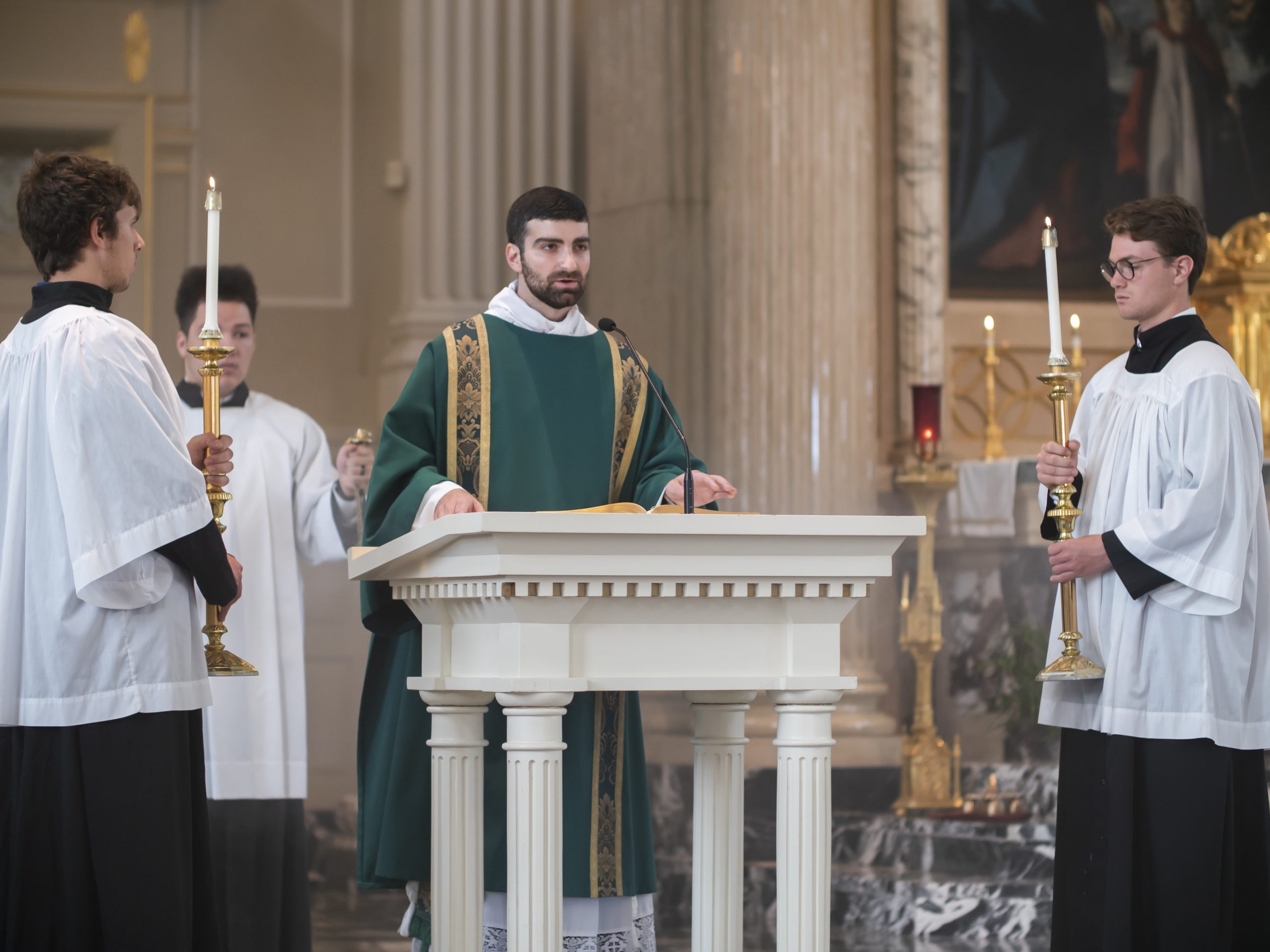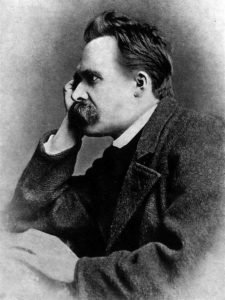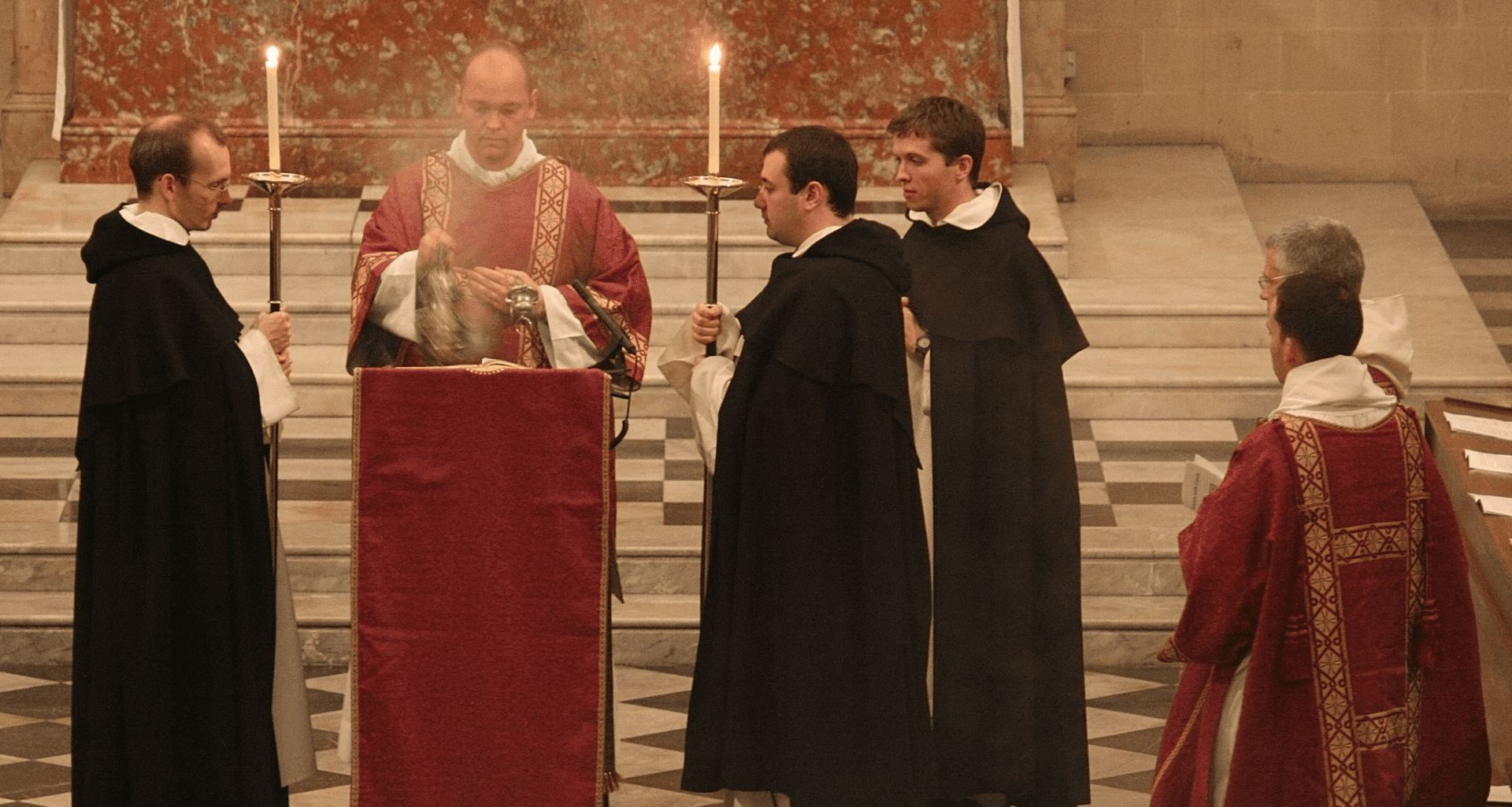Editor’s Note: This article is based on Father Daniel Cardo’s first address as the Benedict XVI Chair for Liturgical Studies at St. John Vianney Theological Seminary in Denver, which he delivered on September 5, 2019.
It is difficult to be indifferent to the ecclesial crisis we have been experiencing in recent times. Pain, confusion, questions, and insecurities have been strongly present in different but real ways in all of us. Yes, the Church is, as Ratzinger said, “a company always in reform,” in the sense that there is always need for deeper purification; but the specific crisis we have been experiencing indicates a more complicated reality.
And so here we are: facing complex problems, criticized more than ever by the media and academia and even ourselves, with many unanswered questions. But we are here: we want something good, something different—we want to follow Christ, and hope for a new springtime in the Church.
In this context, I want to propose a reflection on the centrality of the sacred liturgy for the renewal of the Church. I do this fully aware that for many people, many good people, this might sound like a case of being obsessed with rearranging the furniture when your house is on fire. Should we spend our time and energies talking about liturgy when there are so many urgencies, so many problems to fix, decisions to make, changes to implement? Isn’t “good liturgy” a luxury, something that might be nice once the real work has been done, something that will come out of the hard labor we have to do now? Who would expect that the care of the liturgy would be the first priority among the pressing works of a chancery, a parish, or a seminary?
Benedict XVI has a different view. Almost two years ago, writing a preface for the Russian translation of his Collected Works on the liturgy, he stated: “The deepest cause of the crisis that has upset the Church lies in the obscuring of the priority of God in the liturgy.” How so? He explains: “The Church’s existence lives from proper celebration of the liturgy and…the Church is in danger when the primacy of God no longer appears in the liturgy nor consequently in life.”[1] It is important to notice one adjective in this sentence: Benedict is not simply saying that the Church lives from the celebration of the liturgy, but from the proper celebration of the liturgy. It is not only about, to put it simplistically, if priests are “saying Mass,” but also about how those Masses—and other liturgical actions—are being celebrated. Similarly, in the words that I used for the title of this lecture, he said: “The Church stands or falls with the Liturgy. The true celebration of the sacred liturgy is at the center of any renewal of the Church.”[2] Any renewal, the renewal that we so honestly desire, has its center in the true celebration of the liturgy. The Church, truly, stands or falls with the liturgy. Why?
Time and Place for God
The key point here is the priority of God and, therefore, the problem of faith. Believers, and the world, need a real encounter with God. And that happens, or it is meant to happen, first and foremost, in the sacred liturgy, which as the Council teaches us, is the source and summit of our life and mission (Sacrosanctum Concilium (SC) 10), the one action not surpassed in efficacy by any other action (SC 9), no matter how pressing or popular. If we do not encounter God in the liturgy because of an improper celebration that becomes an obstacle for the faith of believers, then the Church falls. And notice that improper could mean the extremes of casual and irreverent celebrations, as well as the merely aesthetic concern for gestures or fabrics. The proper celebration of the liturgy must make God transparent to everyone. And this divine transparency comes from faith. And faith comes from this divine transparency.
In the few occasions when the Pope Emeritus has said something from his retirement, he has come back to this idea: faith is at the root of everything. He offered recently a lucid analysis on the sex abuse crisis in which he wondered how these things could have happened, particularly the abuse of minors. “Ultimately, the reason is the absence of God…. Only where faith no longer determines the actions of man are such offenses possible.”[3] The amount of criticism he received for his “naive” reflection was both surprising and predictable. On another occasion, he spoke again saying that the critiques of his analysis only confirm his point: long essays in opposition to his reflections and offering other causes for the crisis revealed yet again the main problem, the absence of God, whose name or whose scriptures were simply absent in the theological writings of his critics.[4]
God himself is the priority, now more than ever. A renewal of faith is the main urgency for the Church. Of course, there are other urgencies, there are complicated problems to handle, and we can only be grateful to those among us who have been working hard to respond to crises of unforeseen dimensions, such as doctrinal confusion, sexual abuse, and financial corruption. But, precisely out of gratitude, we need to move forward, knowing that the solutions for specific crises are not always equal to the keys for a long and lasting renewal of the Church. This renewal arises from faith, from the real encounter with the living God who comes to us, first and foremost, in the true celebration of the liturgy. Nothing is more important, nothing is more urgent.
Unlocking Liturgical Renewal

How can we move ahead on this path of renewal? The testimony and teachings of Benedict XVI can offer important keys for us today. His example is still fresh in our memories: in his years as Supreme Pontiff he established the proper celebration of the liturgy as a real priority, promoting more reverence, silence, adoration, solemnity, beauty, tradition, and leaving us an important body of mystagogical homilies that will be remembered for a long time. But this is not only something from the past. Someone told me of a lay professor who was invited to a small and intimate Sunday Mass at the Mater Ecclesiae monastery (Pope Benedict’s residence) a year ago or so, offered by the Pope Emeritus. Even in his 90’s, in front of a handful of people, the fragile Benedict had written down a beautiful homily for this, humanly speaking, unimportant occasion. But when faith is real, and God is the priority, no Mass is unimportant.
His teachings are abundant, and can be found in Theology of the Liturgy, Volume XI of his Collected Works—the first of the 16 volumes he requested to be published, thus showing, as far as Benedict XVI is concerned, yet again, that there is nothing more important than the liturgy. Based on his writings, I will propose three keys for a fruitful liturgical renewal.
Renewal in Continuity
One of the greatest gifts from Benedict’s liturgical teachings is balance, and particularly, a rich vision of necessary renewal in true continuity with tradition. As we know, liturgy often becomes a visceral source of controversy. Because of this, even great institutions and authors in the Church explicitly choose to completely avoid the topic of the liturgy in their discussions and works. But, is this the answer? Is the desire to avoid the “liturgy wars” enough reason to ignore the source and summit of our life and mission?
A better approach seems to be found in a balanced understanding of liturgical reform, and its place in the concrete life of the Church. And for this, we need to understand tradition, a word that makes some people nervous. Benedict said that tradition is like a river: a living reality, always coming from the source, and always in development.[5] It has to remain the same, and it has to move. The Liturgical Movement of the 19th and 20th centuries, in its original insight, promoted a necessary renewal along these lines, and the Second Vatican Council saw that renewal as a “pneumatic event,” producing then in Sacrosanctum Concilium, “the right inner equilibrium” among the different aspects of the ongoing liturgical reform.[6] The Second Vatican Council, and the liturgical developments that followed it, ought to be interpreted through the “hermeneutic of continuity.”[7]
The Council itself brought about a renewal that was necessary and balanced. But, says Ratzinger, “in the implementation of the conciliar mandate it was easy for the balance of the conciliar document to be disrupted one-sidedly in a specific direction.”[8] While the reforms implemented after the Council are clearly obligatory, “they are not simply identical with the Council.” Therefore, to be open to a revision of today’s liturgy, and to believe that there are things in need of reform, doesn’t mean being an opponent of the Council. In fact, because of this need for revision, it is necessary to always go back to the actual words of the Council.[9] If anyone believes in progress, then it will surely make no sense to believe that progress froze forever in the 70’s. The river of tradition continues to move, and renewal has to be present in the liturgy today as well.
Active Participation
Another important key for a true renewal of the liturgy in the light of the documents of the Council is that of active participation.[10] Sacrosanctum Concilium indicated that “in the restoration and promotion of the sacred liturgy, full and active participation by all the people is the aim to be considered before all else” (SC 14). In The Spirit of the Liturgy, Ratzinger lamented the fact that “unfortunately, the word was very quickly misunderstood to mean something external, entailing a need for general activity, as if as many people as possible, as often as possible, should be visibly engaged in action.”[11] We all have seen, and still see in our parishes, the distorted understanding of active participation as “doing things.”
This reality is connected to a vision of the liturgy centered on ourselves: our preferences, opinions, and needs. Ratzinger criticizes what he calls “a new view” of liturgical celebrations in which “the basic concepts…are creativity, freedom, celebration and community.”[12] For him, this perspective is based on an “anthropocentric error”: a liturgy “constructed entirely for men…, concerned with winning people over or keeping them happy and satisfying their demands.”[13] The liturgy would not be first and foremost the action of glorifying God and sanctifying his people, but a human activity, centered in the community, which finds its own ways of celebrating its faith. The Eucharist, in this context, would be seen basically as a communal meal, and not as the ritual renewal of Christ’s redemptive sacrifice.
But, Benedict is also clear on the proper communal emphasis in today’s liturgy: “the Eucharist cannot adequately be described by the term ‘meal’”[14]—“to speak of the Eucharist as the community meal is to cheapen it, for its price was the death of Christ.”[15] When an assembly sees the Eucharist only as a meal, it becomes “a closed circle that is no longer aware of the explosive Trinitarian dynamism that gives the Eucharist its greatness.”[16]
In light of such insularity, how can we recover the greatness of the Eucharist, and the greatness of the whole liturgical life of the Church? One of Benedict’s most insightful contributions is his idea of the sacrifice of the Word. As we know, at times our celebrations can be a little “wordy,” as if everything had to be explained. But it is not hard to see that, as Ratzinger says, engaging in talk is not the same as speaking a word. And Christian liturgy is the liturgy of the Word, the logike latreia, the worship according to the Logos. This does not mean that the liturgy of the word is the center of our celebrations, but that Christ, the Word made flesh, is the main agent of the liturgy, working through his words.
During a Wednesday catechesis in 2012, Pope Benedict commented on St. Benedict’s indication that our minds must concord with our voices when we pray. He said that in human life thoughts come first, and then the words. But “in the liturgy, the opposite is true, words come first. God has given us the word and the sacred liturgy offers us words; we must enter into the words, into their meaning and receive them within us, we must attune ourselves to these words; in this way we become children of God.”[17] The words of the liturgy, taken from Scripture and Tradition, precede our thoughts, our feelings, our dispositions, and are meant to shape our ways of thinking, praying, feeling, and acting. The more we enter into those words, the more we worship according to the Word. And this leads us to the core of true participation: to take part in the action of Christ, which is a sacrifice of the heart. Just as Israel understood that the sacrifice pleasing to God was a contrite heart, so Jesus transfigured the Passover prayers and gave them “a heart that opens the locked door; this heart is his love…, [for] Jesus Christ transformed his death into verbal form—into a prayer—and, in so doing, changed the world.”[18] The more we pray with the words of the liturgy, which is the prayer of Christ, the more we participate in his offering. This is an important key for us, who celebrate and preside over liturgical celebrations; this is a decisive key as well for our people. We need to help them to enter into the words of the liturgy, and offer a sacrifice of the heart. That will lead them to truly, consciously, and actively participate in the richness of the sacred liturgy.

The Way of Beauty
A final key for liturgical renewal is beauty. This is another complicated point, not only because of the difficulty of going beyond subjective preferences in regards to beauty, but also because at times it seems that some are afraid of true beauty in the Church. The dull average of much modern architecture, ritual, and music in many parishes might have created a false sense of security in keeping things “average.” Beauty seems secondary, when not simply irrelevant or disruptive. Haven’t we all found some comfort in saying, after a poor celebration of the Mass, or one done with irreverence or plain abuses, that at least the “words of consecration” were said? Is that all that matters? Of course, we know the real presence of Christ in the Eucharist will be there even if the rites of the Mass are performed in a sloppy way, as long as the consecratory words are said validly, but when a believer has to struggle to go beyond what he sees and hears in order to keep his faith, one has to admire that perseverance. And when a young person goes to Mass and finds mediocre music and poor preaching, and nothing of what he experiences inspires him, if his faith is not strong, then we shouldn’t be surprised that only 7 percent of millennials raised in the Church still practice their faith, or as a recent Pew Study has shown, only 31 percent of Catholics believe in the real presence. The solution to this situation is not, contrary to what prominent commentators have said, simply to review our catechetical methods. What we are witnessing is the fruit of poorly celebrated liturgies. The solution is, as Benedict insists, a true celebration of the liturgy, which demands beauty.
In his 2007 exhortation, Sacramentum Caritatis, Benedict wrote that “the liturgy is inherently linked to beauty: it is veritatis splendor” (35). Because “in Jesus we contemplate beauty and splendor at their source, [the care for beauty in the liturgy] is no mere aestheticism, but the concrete way in which the truth of God’s love in Christ encounters us, attracts us and delights us” (SCar 35). The liturgy has to offer true beauty. “The encounter with the beautiful can become the wound of the arrow that strikes the heart and in this way opens our eyes.”[19]
Benedict XVI has offered many reflections on different aspects of liturgical beauty, such as architecture, ritual, vestment, and others. Let us only mention three quick points about music. First, music is necessary: “When man comes into contact with God, mere speech is not enough;”[20] the experience of love moves us to sing, as he says in reference to Augustine’s famous cantare amantis est. Second, it is essential to distinguish between religious and liturgical music. They are both valid and important, but also different. Liturgical music, as explained by the Council of Trent, and later by St. Pius X, the Second Vatican Council, and St. John Paul II, finds its standard in Gregorian chant and classical polyphony. As such, “not every kind of music can have a place in Christian worship. It has its standards, and that standard is the Logos.”[21] The priority in liturgical music comes from the Word: the melodies beautifully conform to the texts of the liturgy. This leads us to our last point.
In the years following the Council some influential authors made a drastic distinction between “esoteric” and “utility” music. “Esoteric” music, they said, is the beautiful treasure of the Church’s liturgical tradition that should not be performed in the context of the liturgy, where we should only perform “utility” music, that is, music which is so simple that everyone can participate in it. These ideas have penetrated and dominated the life of parishes worldwide. Ratzinger laments about this: “one thing has become clear in recent years: the retreat into utility has not made the liturgy more open: it has only impoverished it.”[22]
Let me quote a longer passage about this: “A Church which only makes use of ‘utility’ music,” Benedict writes, “has fallen for what is, in fact, useless. She too becomes ineffectual. For her mission is a far higher one. The Church must not settle down with what is merely comfortable and serviceable. Next to the saints, the art which the Church has produced is the only real ‘apologia’ for her history. The Church is to transform, improve, humanize the world, but how can she do that if at the same time she turns her back on beauty, which is so closely allied to love? The Church must maintain high standards; she must be a place where beauty can be at home.”[23]
This is another concrete way to promote liturgical renewal: to be bold and aim higher; to not resign ourselves to the status quo, to what has been done for decades. We know that it does not work! We should not be afraid to promote beauty, according to the musical tradition of the Church, which the Council describes as “a treasure of inestimable value, greater even than that of any other art” (SC 112). This is a significant statement: no other art is greater than music, and in it we should be able to find the beauty of Christ, who himself “becomes the choir director who teaches us the new song and gives the Church the tone and the way in which she can praise God appropriately and blend into the heavenly liturgy.”[24]
How as Much as Why

The renewal of the liturgy is truly at the core of the renewal of the Church, for it is the main way to restore faith and promote the priority of God. The sacred liturgy is, indeed, the source and summit of our life and mission. Not only because in it we find strength, consolation, and grace, but also because in it we receive atonement for our sins. This is particularly true in regard to the Eucharist, as we say in a prayer contained in the oldest Roman sacramentary: “whenever the memorial of this sacrifice is celebrated, the work of our redemption is accomplished.” In the Eucharist we receive more than inspiration and comfort: we are ever more redeemed.
This is why Benedict XVI has called for a new liturgical movement, “a movement toward the liturgy and toward the right way of celebrating the liturgy.”[25] The how, the true, proper, and right celebration of the liturgy is at the center of the renewal of the Church. There is nothing more important, or more urgent we can do for the Church, or indeed for the world.
Nietzsche said once about Christians: “They would have to sing better songs for me to learn to have faith in their Redeemer: and his disciples would have to look more redeemed!”[26] May we assume the renewal of the liturgy in our parishes, singing better songs, celebrating with greater beauty and love, and therefore looking more redeemed, as our first task in these difficult times, as our first service to the Church and to the world, for, as Benedict said to the youth gathered in New York, “the Church’s liturgy is a ministry of hope for humanity.”[27]
[1] https://www.praytellblog.com/index.php/2017/10/04/pope-benedict-xvi-on-the-crisis-of-the-church-god-and-the-liturgy/
[2] Joseph Ratzinger, Preface to Die Heilige Liturgie, quoted by Roberto de Mattei, “Reflections on the Liturgical Reform” in Looking Again at the Question of the Liturgy with Cardinal Ratzinger, ed. Alcuin Reid (Farnborough: Saint Michael’s Abbey Press, 2003), 141.
[3] https://www.catholicnewsagency.com/news/full-text-of-benedict-xvi-the-church-and-the-scandal-of-sexual-abuse-59639
[4] https://www.catholicnewsagency.com/news/benedict-responds-to-criticism-of-his-essay-on-the-church-and-the-sexual-abuse-crisis-51446
[5] See Benedict XVI, “Address to Participants in the Congress Promoted by the Pontifical Athenaeum of Saint Anselm on the 50th Anniversary of Foundation,” Friday May 6, 2011. Found in https://w2.vatican.va/content/benedict-xvi/en/speeches/2011/may/documents/hf_ben-xvi_spe_20110506_sant-anselmo.html
[6] See Joseph Ratzinger, “Fortieth Anniversary of the Constitution on the Sacred Liturgy,” in Theology of the Liturgy: The Sacramental Foundation of Christian Existence, ed. Michael J. Miller, vol. XI of Joseph Ratzinger, Collected Works (San Francisco: Ignatius Press, 2014), 575.
[7] See Benedict XVI, Sacramentum Caritatis, 3.
[8] Joseph Ratzinger, “Fortieth Anniversary of the Constitution on the Sacred Liturgy,” in Collected Works, XI:575.
[9] See Ibid., 575-576.
[10] For a thorough review of the usage and evolution of this concept see Daniel Van Slyke, “Actuosa Participatio from Pius X to Benedict XVI: Grace and Gregorian Chant,” in Antiphon 29.2 (2019): 101-144.
[11] Joseph Ratzinger, “The Spirit of the Liturgy,” in Collected Works, XI:106.
[12] Joseph Ratzinger, “On the Structure of the Liturgical Celebration,” in Collected Works, XI:319.
[13] Joseph Ratzinger, “Eucharist and Mission,” in Collected Works, XI:332.
[14] Joseph Ratzinger, “The Spirit of the Liturgy,” in Collected Works, XI:78.
[15] Joseph Ratzinger, “On the Structure of the Liturgical Celebration,” in Collected Works, XI:322.
[16] Joseph Ratzinger, “On the Question of the Orientation of the Celebration,” in Collected Works, XI:390.
[17] http://w2.vatican.va/content/benedict-xvi/en/audiences/2012/documents/hf_ben-xvi_aud_20120926.html
[18] Joseph Ratzinger, “The Eucharist—Heart of the Church,” in Collected Works, XI:265. See also “The Spirit of the Liturgy,” in Collected Works, XI:106-110.
[19] Joseph Ratzinger, Encounter with CL 2002, in http://www.vatican.va/roman_curia/congregations/cfaith/documents/rc_con_cfaith_doc_20020824_ratzinger-cl-rimini_en.html
[20] Joseph Ratzinger, “The Spirit of the Liturgy,” in Collected Works, XI:88.
[21] Ibid., 94.
[22] See Joseph Ratzinger, “On the Theological Basis of Church Music,” in Collected Works, XI: 421-424.
[23] Ibid., 440-441.
[24] Joseph Ratzinger, “Theology of Church Music,” in Collected Works, XI: 497.
[25] Joseph Ratzinger, “The Spirit of the Liturgy,” in Collected Works, XI: 4.
[26] Thus Spoke Zarathustra, ed. Walter Kaufmann (New York: Penguin, 1982), 204.
[27] Benedict XVI, Meeting with Young People and Seminarians in New York, 2008, in http://w2.vatican.va/content/benedict-xvi/en/speeches/2008/april/documents/hf_ben-xvi_spe_20080419_st-joseph-seminary.html


